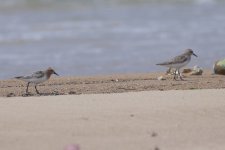xuky.summer
Well-known member
My friend photographed these two sandpipers today at noon in Qingdao City, Shandong Province. The one on the left is a Red-necked Sandpiper, while the one on the right looks a bit unusual. It lacks obvious red coloration on the foreneck, has long legs and a long bill, which doesn’t match the typical breeding plumage of a Red-necked Sandpiper. However, the pattern on its scapulars also doesn’t seem to align with a Little Sandpiper.
What could this bird be? Thank you very much
What could this bird be? Thank you very much







